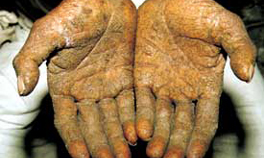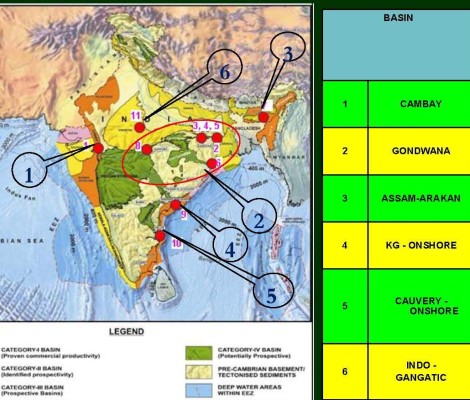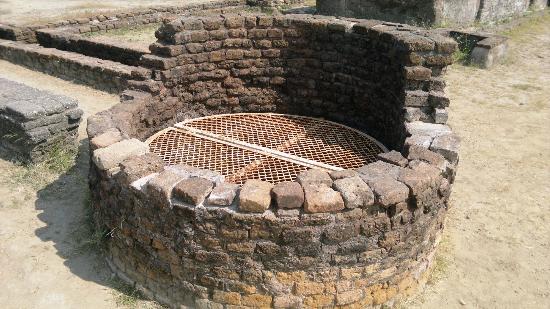Above: Well at Lothal, possibly more than 4000 years old Photo : Srijan Bhatt, 2013
Over the last 3-4 decades, groundwater has emerged as the main source for all uses including irrigation. According to the World Bank, “India is the largest groundwater user in the world”. It has a relatively decentralized access and is convenient to use, making it the backbone of India’s agriculture and drinking water security. As a common pool resource, it also remains the only source of drinking water for most rural households. Almost 60% of the water used for irrigation in India is groundwater[1]. Estimates show that nearly 50% of urban drinking water comes from underground sources[2]. The 12th Five Year Plan recognizes that groundwater is being exploited beyond sustainable levels and with an estimated 30 million groundwater structures in play, India may be hurtling towards a serious crisis of groundwater over extraction and quality deterioration. In fact, according to the World Bank report, “If current trends continue, within 20 years 60 percent of all aquifers in India will be in a critical condition (World Bank 2005)”[3].

Quality of groundwater also needs attention. There is a dearth of safe drinking water in many parts of the country.The groundwater crisis seems to be embedded at two different levels: depletion of aquifers (quantity) and their contamination (quality).
Challenge of Quantity:
According to the 12th Five Year Plan, groundwater decline ranges from <1m to 4m annually in various parts of the country.
The report of the Expert Group on Groundwater Management and Ownership of the Planning Commission (2007), had reported that in 2004, 28 per cent of India’s blocks were showing alarmingly high levels of groundwater use. In another instance demonstrating depletion, an assessment by NASA showed that during 2002 to 2008, India lost about 109 Billion Cubic Metres (BCM) of groundwater leading to a decline in water table to the extent of 0.33 metres per annum.
The Central Ground Water Board (CGWB) monitors groundwater levels four times a year: pre-monsoon (March/April/May), August, November and January at around 11000 wells in the country, but this number sites is till not representative of the large no of aquifers or the 30 million Indian users.
In this groundwater monitoring, CGWB takes into account various regional changes in groundwater levels. Apart from the draft of groundwater for various purposes, quantum of rainfall and its component being recharged to the ground is a major controlling factor of the depth to water levels and its fluctuations. According to the CGWB report for the time period of January 2013- January 2014, it was seen that out of the 11,204 wells studied, about 66% showed a rise in water levels, 31% recorded a fall and there was no change recorded in 2% of the wells[4]. The report concluded that in general, there is a rise in water levels in the entire country. The report seems to be giving erroneous picture, possibly due to the good monsoon of 2013 when the long term trends are contrary to this.
However, the Union Minister of State of Water Resources recently informed Lok Sabha that around 56% of the wells in the country showed a decline in their levels in 2013 as compared to the average of the preceding decade (2003-2012)[5]. As per this information, 76% wells in Tamil Nadu, 72% wells in Punjab, 71% wells in Kerala, 69% wells in Karnataka, 66% wells in Meghalaya, 65% wells in Haryana, 64% wells in W Bengal & 62 % wells in Delhi showed depletion.
But the CGWB report does not tell us what the quality of water is like, or how feasible it is to use the available water. According to a study on the water situation in Punjab, a farmer had to sell off 4 acres of his ancestral farmland at a village in Patiala because it had turned less productive thanks to the groundwater level receding from 70-80 feet pre-1990s to 400 feet today. “Even the water available at this depth is not good for irrigation. Those who can afford it, dig bore wells at around 1,000 feet which yields good quality water”[6]. The 12th Five Year Plan states that the absence of rational pricing for canal water, combined with free or very cheap power for agriculture, has encouraged agricultural practices which are extremely wasteful. Cheap power has encouraged excess drawal of groundwater leading to falling water tables in large parts of the country. However groundwater situation is much more complex to fit into narrow economic framework, the key issues in groundwater remain need for bottom up community driven regulation and protection and multiplication of groundwater recharging systems.

In Maharashtra, it has been reported that indiscriminate groundwater abstraction is leading not only in fall of groundwater levels, but shrinking of ‘paleo-historic storages’ which can be many millenia old. One of the culprits is sugarcane cultivation in the drist parts of the state, leading to critical watersheds. According to GSDA in Maharashtra, groundwater table in some places has decreased to as much as a metre or more due to pumping.

The 12th Plan recognizes that water balances for the country as a whole are of limited value since they hide the existence of areas of acute water shortage, to say nothing of the problems of quality.
The challenge of Quality:
In addition to depletion, many parts of India report severe water quality problems, causing drinking water vulnerability and huge livelihood impacts. According to reports, as we drill deeper for water, our groundwater can get contaminated with fluoride, arsenic and other impurities. In the Punjab example, it was seen that wells have to be dug deeper because of depleting groundwater, thus increasing the chances of contamination. In coastal areas salinity increases as we deplete the aquifers. Due to lax pollution control, industries in many parts of India are known to pump untreated toxic effluents into the aquifers. The untreated effluents released into the streams and rivers also affect the groundwater. Such impacts are irreversible on long term basis.

It has been reported this year that the western zone bench of the National Green Tribunal (NGT) in Pune has prohibited unauthorized extraction of groundwater for commercial use by businesses dealing with packaged water. This measure was taken following a petition filed by city-based Sahayog Trust stating adverse effects of high levels of fluoride in groundwater on people’s health. It stated that high levels of fluoride in groundwater were affecting villagers’ health in 12 districts[7]. This unchecked exploitation of groundwater is due to the rampant and illegal drilling of bore wells, which are dug deeper than the permissible levels, causing contamination.

According to a recent analysis of groundwater in Delhi, almost 30 per cent of the samples were found to contain high levels of fluoride which are beyond permissible limits. Areas in West, South-West and some of New Delhi are also affected by significant nitrate levels, caused most probably by the improper disposal of waste and sewage water around the wells. According to the report, with the Delhi Jal Board not being able to provide clean drinking water to all areas, the people dependent on direct extraction wells and tankers are at highest risk[8]. Similarly in Bengaluru, a whopping 99.1% samples tested by Mines and Geology Department of the state in 2011 were unfit for human consumption due to nitrates, iron, fluoride and excessive minerals (hard water).[9]
A rising concern for groundwater quality is the introduction of a new process of hydraulic fracturing, or fracking. The fracking process is used to extract shale gas which is very different from conventional gas production. Unlike conventional gas extraction, which requires a well to be dug in the area where the gas is found, shale gas is found dispersed in a large area, trapped amidst impermeable rock. Its extraction requires drillers to smash rocks forcing millions of gallons of water and chemicals through cracks[10]. The US has been a pioneer in promoting and using the technology in the hope of attaining energy independence.

Last year, the government allowed ONGC and RIL to experiment with the extraction of shale gas. Under this policy, aimed at boosting domestic output of fossil fuels,the above companies are most likely to be permitted to extract oil and gas from shale rocks. While the implementation of this technique is underway, according to a 2013 report, France has banned fracking on concern the process contaminates underground water supply, while Germany proposes to outlaw the procedure in protected areas of the country9.
It has been seen in regions of other countries which are using fracking, e.g. in the US, that it has led to serious groundwater contamination. The major problem is the generation of waste toxic water which is formed after pumping water through the cracks for gas extraction. This waste water is disposed in the deeper layers of the earth, causing contamination of aquifers.

Government policies:
Till now, there were no effective plans by the government for managing groundwater resources. In the 12th Five Year Plan, government aims to map sources of groundwater, i.e., the aquifers. Groundwatter regulation requires a change in the policies of governance as some important legal principles governing groundwater even today were laid down in the British common law as early as the middle of the nineteenth century and have not been updated since then.
This plan proposed an Aquifer Mapping Programme2. The aim is to bring “sustainable management of our aquifers to the forefront of policymaking”. This programme seeks to map the quality, quantity and sustainability of groundwater in aquifers and encourage better groundwater management plans at the appropriate scale. It was meant to be a prerequisite and a precursor to the National Groundwater Management Program. This started in 2012 and aimed to finish its pilot study by 2013. It includes the constitution or reformation of State agencies for groundwater and also seeks the participation of research institutes and civil society.
The government in its twelfth five year plan had also proposed a policy for participatory groundwater management2, which means that there would be implementation through collaborative approach amongst central and state organizations, research institutes, NGOs, and the local community. The management plans under this programme are to be executed by trained community workers/volunteers. This also allows for the data to be collected by grass root workers, who are also engaged in sensitizing the local population about the general trends and optimal use of groundwater. But these government efforts are yet to show any results.

It is clear that the government has completely failed on the groundwater front. First step towards recovery will be through the acceptance that groundwater is India’s water lifeline and is going to remain so for many decades to come. It needs to recognise this in the National Water Policy, Plans and programmes. Secondly, all water resources efforts need to focus on sustaining this groundwater lifeline. In this direction, community-driven management, protection of existing groundwater recharge systems and creation of many such systems have to be key elements. In spite of the serious threat to India’s groundwater lifeline, which is further accententuated in the context of changing climate, there is little progress in achieving any of these steps. It seems the groundwater situation is likely to worsen before there is any hope for improvement.
Padmakshi Badoni, SANDRP (padmakshi.b@gmail.com), with inputs from Himanshu Thakkar (ht.sandrp@gmail.com)
[1] http://www.globalwaterforum.org/2013/08/19/groundwater-resilience-to-human-development-and-climate-change-in-south-asia/
[2] http://planningcommission.gov.in/plans/planrel/12thplan/pdf/12fyp_vol1.pdf
[3] http://documents.worldbank.org/curated/en/2010/01/11899840/deep-wells-prudence-towards-pragmatic-action-addressing-groundwater-overexploitation-india
[4] http://cgwb.gov.in/documents/GW%20LEVEL%20SCENARIO_January%202014.pdf
[5] http://timesofindia.indiatimes.com/india/Depleting-ground-water-levels-cause-of-worry/articleshow/39079749.cms
[6] http://www.indiawaterportal.org/articles/punjab-wades-low-waters
[7] http://timesofindia.indiatimes.com/City/Pune/Green-tribunal-prohibits-groundwater-extraction/articleshow/34447747.cms
[8] http://www.thehindu.com/news/cities/Delhi/quality-of-groundwater-takes-a-dive-too/article6274364.ece
[9] http://www.dnaindia.com/bangalore/report-heavy-metals-contaminating-bangalore-s-groundwater-resources-1526470
[10] http://www.businessweek.com/news/2013-03-31/fracking-debut-nears-in-boost-to-reliance-ongc-corporate-india
[11] http://www.thehindu.com/opinion/op-ed/drilling-holes-in-the-thirst-economy/article4630897.ece by P. Sainath
[12] http://www.punemirror.in/pune/civic/Sugarcane-kills-groundwater/articleshow/39897778.cms

Good article, good reporting.
Depinder
LikeLike
The facts and figures are alert and noteworthy.
-Surya
LikeLike
Good article
Thought provoking
Inspired me to create awareness in my area ….
GROUND WATER
Musolini
LikeLike